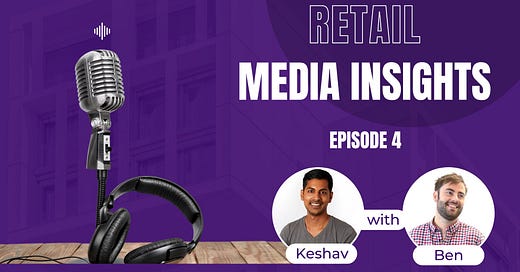My guest for Episode 4 is Ben Foulkes, who is the Commercial Director at Epsilon (now part of the Publicis Groupe). The contents of this episode are available both as a podcast, and in a condensed and lightly edited written format below.
In this episode, we discuss:
(01:24) Ben's background and pet topic of ad saturation
(06:13) Epsilon's 'outcome-based marketing' proposition
(10:29) Activation channels offered by Epsilon
(12:52) Audience building models and capabilities
(15:18) Overlap with data clean rooms
(17:01) Intro to Epsilon's loyalty solution
(18:07) Epsilon's ID based targeting approach
(25:26) Retail data needed for the offsite partnership
(26:43) Challenges for retailers entering offsite media
(28:10) Changes that Ben would like to see in retail media
____________SLIGHTLY EDITED VERSION___________________
Q: Tell us a bit about your favourite topic of ad saturation.
Ben:
I think you'll find many cynics when it comes to programmatic and digital advertising who, after being in it for long enough, have almost kind of lost faith in a lot of the ways in which it works. And saturation is one of those things. So when people think about offsite, most people's thoughts go immediately to retargeting, right? And everyone's got the story of the shoe that follows around the internet.
At Epsilon, we are big advocates of an open internet. We think that part of that is being able to target and show someone the most relevant advert on the internet. Unfortunately, today there is a lot of poor programmatic practices followed. Sometimes, it is not the right advert. It's not understanding the frequency with which you're showing one person. You hear horror stories of people seeing the same ad 30, 40, 50 times. I think the issue for a lot of brands and retailers, which hasn't been fixed, is we know what drives the sale, but we don't necessarily always know the reverse of that - what happened to the other customers who saw the ad numerous times but didn’t buy the product.
I did go down a rabbit hole a few months back in terms of a the amount of adverts that you think we see on a daily basis. So not just on your laptop, but including TV and other channels like out-of-home, and then kind of working out realistically how many adverts a customer needs to see for it to be effective. Realistically it will change per person based on where that person is in the funnel, their propensity to buy from you already etc. But on a monthly basis, anything below eight impressions per customer on digital channels, is unlikely to make any difference in persuading customers to buy your brand. But the there are hurdles in applying this frequency because the same customer may come across with different identities when using different devices (mobile vs. laptop), and it is difficult to apply the aggregate cap across all digital channels (open web and walled gardens).
Q: Epsilon markets itself as an ‘outcome-based marketing solution’. What does it mean?
Ben:
People tend to have quite a difficult time of slotting in Epsilon. We see ourselves a little bit like mad tech. You've got your MarTech landscape and you've got your AdTech landscape. Both those landscapes are terrifying when you look at them.
In MarTech, you have technologies like customer data platforms, first-party data platforms (like DMPs) and perhaps clean rooms. These require quite expensive investments upfront with the hope that by improving what you know about a customer or improving your first party data, your existing marketing can become more effective
LumaScape (adtech landscape) is super complicated and you have lots of different point solutions. Unfortunately, within ad tech, you've now got about 100 different companies that take different parts of that journey and specialize in them, which means ultimately a lack of accountability for the overall outcome. One might be really good at onboarding data and connecting it to an ID. Another might be good at connecting the data to media at scale. And then you've got some who are really good at personalizing a creative. But none one of those are accountable for the chain of events. So when we talk about being outcome based, it's that we take ownership of the overall end to end. Ultimately, advertisers are trying to figure out how do I get the right message to the right person.
Q: What are the solutions Epsilon provides today?
Ben:
We have our digital media solution, which takes first party data, connects it to media and then drives performance. Then you've got onsite personalisation - so understanding what's going on your own website and helping you build different user journey or paths or understand your exit intent and things like that.
Programmatic email, and loyalty solutions. And then obviously when we come into retail media, our onsite ad server capability and sponsor product. And our clean room technologies as well. So there's a whole heap of different solutions, but each one of them is unique in that it takes on that end to end responsibility.
We also have a customer data platform solution in the US which helps clients get all their data and enrich that data into one place. This is being rolled out next year in Europe.
Q: What channels do you enable for activation?
Ben:
We are quite unique in the sense that we have our own end to end products which connects to the open web - i.e., our own demand-side platform. So various different publishers, multiple different exchange networks and own direct publisher network that we've built out with our proprietary header bidding technology. We have connected TV through likes of Roku's Rakuten.
Then going further than that, we are also building out our universal connectors. These will allow us to connect the data and push audiences into channels like YouTube, or Meta (via LiveRamp) or ITV (via InfoSum).
In summary, we have a primary way of delivering, which is through our end to end tool. But then we are also we've also got a multitude of universal connectors where if you want to connect to other ID based channels, that's available as well. All through a single touchpoint for a marketeer.
Q: What options do you provide to advertisers for building audiences for their campaigns?
Ben:
In our platform, if an advertiser wants to kind of prescribe an audience and then just use our platform to push that audience, that's fine by us. But a lot of retailers are finding a lot of value in leveraging our audience models which have been trained for 10, 15 years to deliver various outcomes.
So for example, let's look at a basic outcome of retargeting. Traditional re-targeting models were trained to drive a click, which is where you might see a lot of bad advertising practices because models then optimised to things that might annoy a user. It might get you a click, but it might annoy a user. We train our models to look at A/B testing of audiences to understand what is driving incremental performance for a business. And if you imagine that model has been working on that for 10, 15 years, that's quite a valuable model to use if a business wants to drive incremental sales.
When it comes to retail media, we built models that are designed to optimise towards specific SKUs. So if a brand has a particular product that they've launched, they can use our models to understand the most relevant audience to target and run an activity against it.
I think whether advertiser prescribes their own audience or uses our model to determine the right audience has to be done on a case basis. And then you let the brand choose by looking at the performance of both options.
Q: Where do you overlap with data clean rooms?
Ben:
Clean rooms currently have come to mean so many different things. I'll be lying to say there wasn't overlap because it feels like clean rooms seem to overlap with so many things now. Where we overlap most with clean rooms is when it comes to taking first-party data, building audiences and then activating audiences.1 Data collaboration use case is a later phase technology that we have. Some of our more aggressive retail media clients in the US are using this clean room capability. In the UK, it's something that we're kind of talking about, but we're not sure how many retailers are there yet in terms of fully going down the road of mixing their data with brands.
Q: Epsilon has its own identity solution called CoreID. In very basic terms, can you explain what an identity solution is?
Ben:
A customer of a retailer will have multiple identities - email addresses, customer ID, guest ID, cookie IDs (which will be different for web and mobile for the same customer) etc. An identity solution collapses these different identity variables into one unique identifier for that customer.
Q: How does ID based targeting work on the open internet?
Ben:
When you've got a retargeting partner on your website, what they'll be doing is when someone comes to your website, they'll be dropping a cookie on that individual. They will also at the same time be syncing that cookie with their exchange partners, or if they've got their own publisher network, they'll be syncing it with the cookie IDs that they have. This way the re-targeting partner can identify it is the same person across two websites.
Now, as we know, third party cookies are going away. So there are two parts to what an ID solution should be doing. First, it needs to bridge the gap created by deprecation of cookies. Second, if you're asking what an epsilon ID based solution will be doing, it is connected to a retailer's customer data and so when that person arrives on the website, we will make a decision based on much more information about that particular person than what's just happened on the website.
For example, as a business you might be looking to acquire more customers. Immediately then, if I know that that person who's landed on the website is a VIP or a repeat customer, when it comes to that person going to a different website, I make the decision not to show you an advert. A lot of people talk about ID in terms of targeting, but what we find is actually it's very effective and it should be used much more often is the ability to more accurately exclude audiences.
Q: If a retailer has 100 of their customers for re-targeting, but only 60 of those match to your ID solution, how do you deal with the remaining unmatched 40 customers?
Ben:
Currently, we can only activate those that match to our ID. Again, that's where we are different as compared to the other ID solutions, as it stands, we have the highest connection into reach (aka match rates).
Q: What data do retailers need to provide to start a partnership with Epsilon?
Ben:
When it comes to offsite media, what we're looking to do is try and understand when's the right time to speak to someone, what's the most important thing to show them and how often. For a retailer, what that means is getting their customer file data, transactional file data, shopper data, any particular attributes about them, and then combining that with online behavioral data that you can capture from a website.
That's the best case. But that might not be possible for all businesses because everyone has their own different privacy concerns. So we start from that and then work work backwards depending on what a retailer is able to share. The bare minimum would be just web behavioral data but as I said the real value for businesses is being able to understand that pattern of purchase.
Q: When you approach retailers for the offsite media space, what are the most common challenges you hear back from them?
Ben:
A lot about privacy. The main concern as it should be for a retailer is their customer data being sacred and protected and that being the center of every decision that they make.
It's also it's a complicated space. You're combining traditional data people with advertising technology, which is very fast moving, . So you're blurring and blending two almost different art forms, which means that there's a lot of miscommunication. So just being able to articulate what's happening is challenging within a retailer.
The other thing for businesses when they're looking into data monetization is that offsite media is lower margin than onsite media. So how do you justify the business case and forecast potential returns? And how do you use that to secure the resource to set yourself up properly?
Q: What is the one change you wish would happen in the retail media industry specifically?
Ben:
I will give two. First is that it is just so performance focused. We haven't learned from mistakes of digital past. There's so much that we can be doing with retail media, but I think 80 percent of retail media spend online is sponsored product. And I think if we look at the opportunities that we have in retail media, where retailers have access to first party data and a view on the same person over a longer period of time, is that lends itself to much more brand based measurement and methodology. So a lot of money is going into MMM models currently within businesses. Retailers have access to a long lifespan of an audience where I think brands can understand what they're doing to change behavior in their audiences, which again are more brand based insights versus performance based insights. I worry we're going to miss a trick, for retailers to really demonstrate the value of their data.
And then the second one is learning from the mistakes of publishers. So there's a definite race here. I think some businesses see retail media as a cash cow.How do I monetise as quickly as possible? And that can involve making your retail data readily available. But as soon as the cat's out of the bag, the cat can't go back in the bag. I think a bit more patience needs to be shown for retailers to properly understand kind of the value of the nest egg they're sitting on and make sure that they go through the right steps to maximise the value of the data asset versus racing to the finish line. And potentially then in two or three years trying to undo some of the things they might've done.
This is similar to where DSPs, like The Trade Desk, overlap with clean rooms.









Share this post